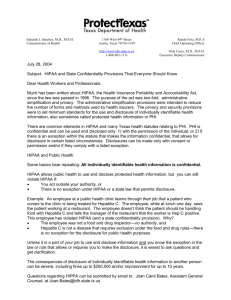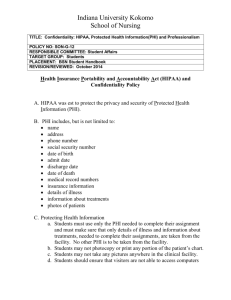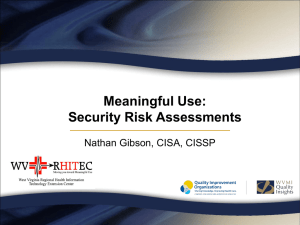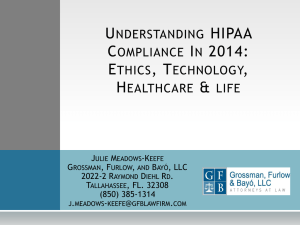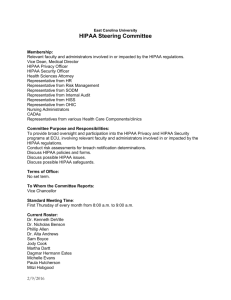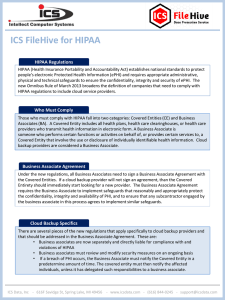Access Policy Doc
advertisement
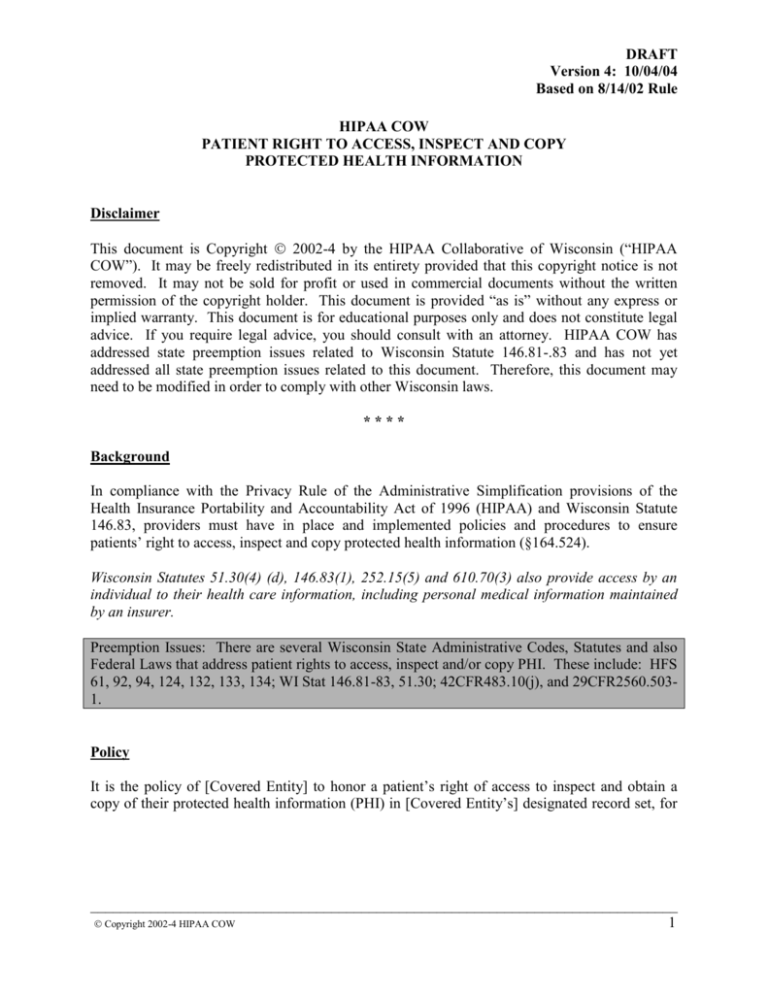
DRAFT Version 4: 10/04/04 Based on 8/14/02 Rule HIPAA COW PATIENT RIGHT TO ACCESS, INSPECT AND COPY PROTECTED HEALTH INFORMATION Disclaimer This document is Copyright 2002-4 by the HIPAA Collaborative of Wisconsin (“HIPAA COW”). It may be freely redistributed in its entirety provided that this copyright notice is not removed. It may not be sold for profit or used in commercial documents without the written permission of the copyright holder. This document is provided “as is” without any express or implied warranty. This document is for educational purposes only and does not constitute legal advice. If you require legal advice, you should consult with an attorney. HIPAA COW has addressed state preemption issues related to Wisconsin Statute 146.81-.83 and has not yet addressed all state preemption issues related to this document. Therefore, this document may need to be modified in order to comply with other Wisconsin laws. **** Background In compliance with the Privacy Rule of the Administrative Simplification provisions of the Health Insurance Portability and Accountability Act of 1996 (HIPAA) and Wisconsin Statute 146.83, providers must have in place and implemented policies and procedures to ensure patients’ right to access, inspect and copy protected health information (§164.524). Wisconsin Statutes 51.30(4) (d), 146.83(1), 252.15(5) and 610.70(3) also provide access by an individual to their health care information, including personal medical information maintained by an insurer. Preemption Issues: There are several Wisconsin State Administrative Codes, Statutes and also Federal Laws that address patient rights to access, inspect and/or copy PHI. These include: HFS 61, 92, 94, 124, 132, 133, 134; WI Stat 146.81-83, 51.30; 42CFR483.10(j), and 29CFR2560.5031. Policy It is the policy of [Covered Entity] to honor a patient’s right of access to inspect and obtain a copy of their protected health information (PHI) in [Covered Entity’s] designated record set, for ______________________________________________________________________________ Copyright 2002-4 HIPAA COW 1 DRAFT Version 4: 10/04/04 Based on 8/14/02 Rule as long as the PHI is maintained in compliance with HIPPA and [Covered Entity’s] retention policy.1 Procedures 1. A patient must make a request to a staff member to access and inspect their protected health information. Whenever possible, this request shall be made in writing and documented on either the “Authorization for Disclosure” form or in the notes of the patient’s health record. 2 3 2. Determination of accessibility of the information shall be based on: a. Availability of protected patient information (i.e., final completion of information, long term storage, retention practices, etc.)4 3. The organization must take action within a reasonable period of time or within 30 days after receipt of the request when the PHI is on-site, and within 60 days when the PHI is off-site. One 30-day extension is permitted, if the organization provides the patient with a written statement of the reasons for the delay and the date by which the access request will be processed.5 4. The organization must document and retain the designated record sets subject to access, and the titles of persons or offices responsible for receiving and processing requests for access. 5. The organization must document and retain the designated record sets subject to access, and the titles of persons or offices responsible for receiving and processing requests for access.6 1In compliance with the Privacy Rule of the Administrative Simplification provisions of the Health Insurance Portability and Accountability Act of 1996 (HIPAA), providers must have in place and implemented policies and procedures to ensure the patients’ right to access and amend protected health information in the designated record set (§164.524 and 164.526). 2 Comment: This procedure, as written, is fairly restrictive. It requires that a request be made to a staff member when a more global format with brackets allowing insertion of the designated staff member’s title or position might be more appropriate. It also requires that the request for access be documented in one of two ways, both relating to health care provider practices. It may be more helpful to state that the access will be documented and what will be included in the documentation rather than to restrict the location of the documentation. Also, an authorization for disclosure is not required for patient access and might not be used under the circumstances of this policy. See Appendix A. 3 Comment: It would be helpful to insert language which addresses an allowance to provide access to the individual without a written request in the event such access might be necessary. HIPAA states that the CE “may require” the individual to make the request in writing, “provided that it informs the individual of such a requirement. See Appendix A. 4 Comment: See Appendix B relating to access by individual. 5 Comment: See Appendix C relating to timeliness of answering request. 6 Comment: See Appendix A relating to documentation required relating to patient access. ______________________________________________________________________________ Copyright 2002-4 HIPAA COW 2 DRAFT Version 4: 10/04/04 Based on 8/14/02 Rule Access, Inspection and/or Copy Request is Granted 6. The patient and the organization will arrange a mutually convenient time and place for the patient to inspect and/or obtain a copy of the requested PHI. Inspection and/or copying of PHI will be carried out within the organization with staff assistance.7 7. The patient may choose to inspect the PHI, copy it, or both, in the form or format requested. If the PHI is not readily producible in the requested form or format, the organization must provide the patient with a readable hard copy form, or other form as agreed to by the organization and the patient. a. If the patient chooses to receive a copy of the PHI, the organization may offer to provide copying services. The patient may request that this copy be mailed. b. If the patient chooses to copy their own information, the organization may supervise the process to ensure that the integrity of the patient record is maintained. 8. Upon prior approval of the patient, the organization may provide a summary of the requested PHI. 9. The organization may charge a reasonable fee for the production of copies or a summary of PHI, if the patient has been informed of such charge and is willing to pay the charge. 10. If upon inspection of the PHI the patient feels it is inaccurate or incomplete, the patient has the right to request an amendment to the PHI. The organization shall process requests for amendment as outlined in additional organizational policy/procedures addressing this patient right. Access, Inspection and/or Copy Request is Denied in Whole or in Part 11. The organization must provide a written denial to the patient. The denial must be in plain language and must contain: a. The basis for the denial; b. A statement, if applicable, of the patient’s review rights; and c. A description of how the patient may complain to the organization or to the Secretary of Health and Human Services. 12. If access is denied because the organization does not maintain the PHI that is the subject of the request, and the organization knows where that PHI is maintained, the organization must inform the patient where to direct the request for access. 7 Comment: See Appendix ______________________________________________________________________________ Copyright 2002-4 HIPAA COW 3 DRAFT Version 4: 10/04/04 Based on 8/14/02 Rule 13. The organization must, to the extent possible, give the patient access to any other PHI requested, after excluding the PHI as to which the organization has grounds to deny access. 14. If access is denied on a ground permitted under (HIPAA) §164.524, the individual has the right to have the denial reviewed by a licensed health care professional who is designated by the organization to act as a reviewing official and who did not participate in the original decision to deny. 15. The patient must initiate the review of a denial by making a request for review to the organization. If the patient has requested a review, the organization must provide or deny access in accordance with the determination of the reviewing professional, who will make the determination within a reasonable period of time. 16. The organization must promptly provide written notice to the patient of the determination of the reviewing professional. See #10 above for denial requirements. **** References “Checklist of Individual Rights Under HIPAA,” Report on Medicare Compliance, April 25, 2002 AHIMA Practice Brief: Patient Access and Amendment to Health Records, 2002 Reinhart, Boerner, Van Deuren, Attorneys at Law 2002 WEDI – SNIP Security and Privacy Workgroup Privacy Policies and Procedures Wisconsin Statute 146.83. Chapter 146 HIPAA Privacy Standards Matrix Authors Nancy Davis, MS, RHIA Sheila Zweifel, RHIT Reviewed by Julianne Dwyer, legal intern, UW Law School student Pre-emption Revisions for Wis. Stat. 146 By: Susan Manning, JD, RHIA ______________________________________________________________________________ Copyright 2002-4 HIPAA COW 4 DRAFT Version 4: 10/04/04 Based on 8/14/02 Rule Appendix A (Based on Procedure 1) A patient must make a request to a staff member to access and inspect their protected health information. Whenever possible, this request shall be made in writing and documented on either the “Authorization for Disclosure” form or in the notes of the patient’s health record. 146.83(1) An individual may inspect or copy their records upon the submitting a statement of informed consent. HIPAA HIPAA allows access upon request. Requires written informed consent. HIPAA allows CE to require request to be in writing provided CE informs individual of such requirement. Request made to CE. Implies written informed consent submitted to health care providing maintaining the requested records. Interface Follow HIPAA. No statement of informed consent is required for patient access. Only request for access is required. CE may require request in writing and this requirement is at the discretion of the CE. CE must notify individual of “in writing” requirement. CE designates who receives request. This request shall be made in writing and documented on either the “Authorization for Disclosure” form or in the notes of the patient’s health record. 146.83(3) The health care provider shall note the time and date of each request, the name of the inspecting person, the time and date of inspection, and identify the records released for inspection. HIPAA There are no specific requirements for documentation of a disclosure to patient under the patient right of access other than documentation of the designated record sets that are subject to access and the titles of the persons/offices responsible for receiving and processing requests for access. HIPAA does not require that a CE provide an individual with an accounting of disclosures made to the individual. Interface State law controls. State law requires greater recordkeeping. Disclosures made to the individual must be documented as required by state law. ______________________________________________________________________________ Copyright 2002-4 HIPAA COW 5 DRAFT Version 4: 10/04/04 Based on 8/14/02 Rule 146.83(3) There is no requirement relating to where the documentation of the disclosure to the individual must be maintained. HIPAA No requirement. Interface Location of the required documentation is at the discretion of the CE and is not regulated by law. Appendix B (Based on Procedure 2.a) Determination of accessibility of the information shall be based on State and Federal laws. If the requested health care information is regulated by Wisconsin statute 146.83, the following grid may be used to determine whether the requested information is accessible by the patient. Wisconsin Statute 146.83 and HIPAA - Interface based on 146 Matrix 146.83 Access to health care records of a health care provider pertaining to that patient HIPAA Access to PHI about the individual in a designated record set with the following exceptions. Does not except any records from patient access. Does not allow patient access to psychotherapy notes. Does not except any records from patient access. Does not allow access to information compiled in reasonable anticipation of, or for use in, a civil, criminal, or administrative proceeding Does not allow access to protected health information that is subject to CLIA or exempt from CLIA. Unreviewable grounds for denial Reviewable grounds for denial. Limits access to information maintained within the record set. Does not except any records from patient access. Interface HIPAA provides a greater right of patient access to a greater amount of information. HIPAA will regulate the information available through the designated record set definition If psychotherapy notes are 51.30 records, 51.30 will control access. If psychotherapy notes are 146 records, access will be provided by state law, 146, superceding HIPAA. Follow state. Accessible by patient. Follow state. Accessible by patient. Does not except any records Follow state. Disregard unreviewable from patient access. process. Does not except any records Follow state. Disregard from patient access. reviewable process. Does not except any records May limit access to what CE from patient access but maintains/retains. practice would limit access to what has been ______________________________________________________________________________ Copyright 2002-4 HIPAA COW 6 DRAFT Version 4: 10/04/04 Based on 8/14/02 Rule 146.83 maintained/retained. Does not exempt records from patient access due to incompletion of records. HIPAA Limits access to information within the designated record set. Interface If Wisconsin law provides greater access, Wisconsin law will control. Appendix 3 (Based on Procedure 3) The organization must take action within 30 days after receipt of the request when the PHI is onsite, and within 60 days when the PHI is off-site. One 30-day extension is permitted, if the organization provides the patient with a written statement of the reasons for the delay and the date by which the access request will be processed. 146 Upon reasonable notice HIPAA Interface Requires action within 30 days The HIPAA time limits will of receipt of request control unless the WI standard (b)(2)(i) of reasonable notice may be deemed to be shorter and provide a greater right of access. Suggest HIPAA language and “upon reasonable notice”, whichever is of shorter duration. Allows 60 days from date of As above receipt of request if information is not maintained or accessible to CE on-site (b)(2)(ii) Allows 30 day extension to As above above if certain procedural steps are taken (b)(2)(iii) ______________________________________________________________________________ Copyright 2002-4 HIPAA COW 7


